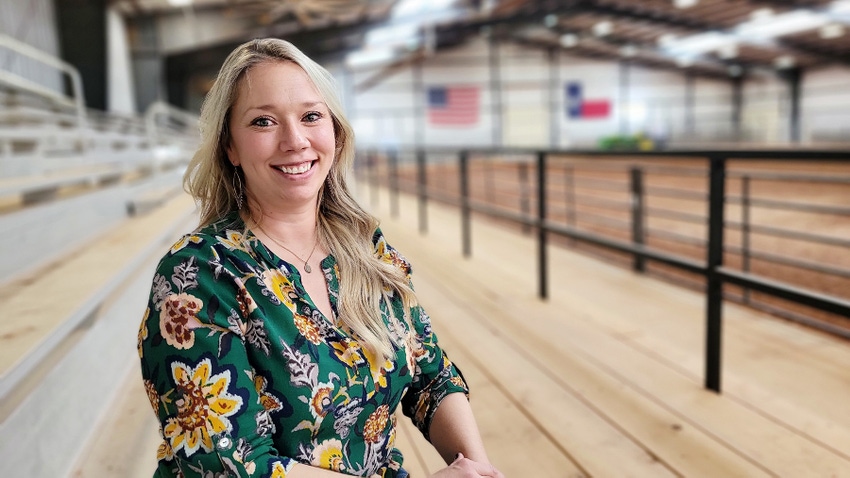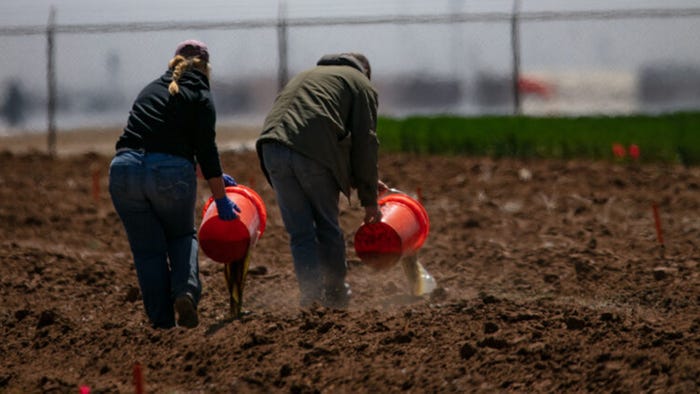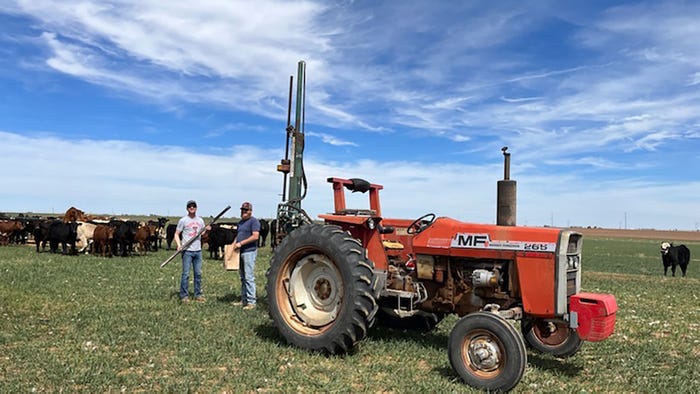
Fertilizer prices spiked over the past few years amid supply and demand issues, and that’s when Katie Lewis, Texas A&M AgriLife Research soil scientist, Lubbock, took on several projects to examine manure-based fertilizers and their management in cropping systems.
Producers are looking for environmentally and economically sustainable management strategies for their cropping systems, Lewis said, and they want to determine how manure fits in as a possible fertilizer source.
In the five-year “Sustainable Agricultural Intensification and Enhancement Through the Utilization of Regenerative Agricultural Management Practices” project funded by a U.S. Department of Agriculture National Institute of Food and Agriculture grant, Lewis is determining the value of manure in relation to carbon sequestration, greenhouse gas emissions and cover crops with on-farm testing.
In a separate study funded by Shell International Exploration and Production Inc., she will be examining small-plot nutrient sources at the Texas A&M AgriLife Research and Extension Center,Lubbock,during the 2023 and 2024 growing seasons. This project is a thesis project for her master’s degree student, Tessa Bennett.
“With fertilizer prices still high, producers are looking to alternative forms of nitrogen, phosphorus and potassium,” Lewis said. “And that’s where the manure sources come into play. This research also focuses on climate-smart practices, including incorporating organic sources of nutrients into your production systems. And so, we’ll be collecting data that will either support the use of manure from a greenhouse gas perspective, or possibly determine if there are negatives to the use of manures.”
She said one of the big concerns when applying manure — which stimulates lots of microbial activity — is the potential for large losses of carbon dioxide, ammonia and nitrous oxide from the soil. Those losses need to be evaluated.

Liquid manure is being applied on small plots at the Texas A&M AgriLife Research and Extension Center at Lubbock as a part of an Shell International Exploration and Production Inc.-funded project to evaluate manure-based fertilizers. (Texas A&M AgrILife photo by Hector Valencia)
The USDA- and Shell-sponsored projects support research studies; the information collected from each will benefit the other, Lewis said.
“Because we aren’t able to dive as deep when we’re doing on-farm studies to really get a better idea of what’s contributing to greater carbon sequestration on this farm versus that farm, the study that we’re doing with the different manure sources amongst cropping systems will allow us to hopefully pinpoint different management strategies that are causing certain effects in the large farm study.”
Digging in on manure processing methods
The Shell International-sponsored project will evaluate different sources or processing methods of manure. South Plains Compost of Lubbock provided raw manure and compost, Lewis said, offering special thanks for their help in getting it applied. Digestate, the material remaining after the anaerobic digestion of a biodegradable feedstock, and the liquid manure were provided by Shell International. Lewis and her team are in the process of applying these different fertilizer treatments to test plots.
This evaluation of manure sources will also examine wheat and cotton production and monitor greenhouse gas emissions and carbon sequestration potential. The goal is to assess the effect of anaerobic digestate and manure applications on crop growth and soil greenhouse gas emissions.
The project will test six treatments on three different cropping systems, with three replications. The cropping systems include wheat cover crop followed by continuous cotton, fallow and cotton followed by wheat, and fallow and wheat followed by cotton.
For each cropping system, the following treatments will be tested:
Crop with no fertilizer or manure.
Crop with typical inorganic fertilizer management.
Crop with pre-plant commercial composted feedlot manure.
Crop with pre-plant provided separated dairy feedlot manure.
Crop with pre-plant provided whole digestate.
Crop with pre-plant commercial raw feedlot manure.
For each plot, the research team will collect data on crop emergence, root zone soil characterization, soil nutrient exchange probes, plant biomass/yield and plant composition. In addition, the greenhouse gases carbon dioxide, methane, nitrous oxide and ammonia will be measured on the soil surface.
Monitoring economic, environmental effects of on-farm natural application
The larger USDA-funded regional regenerative agriculture project monitors greenhouse gas emissions from farms.
“We’re looking at farmers’ fields where compost has been applied, where it hasn’t been applied, where cows are grazing, where they’re not grazing,” Lewis said. “We are just taking what the farmers are doing, not changing any of their management strategies, and we are monitoring carbon sequestration potential from those systems on a large scale.”
She said the team has been collecting soil samples from Stanton all the way up to the Dalhart area, and those samples are being processed.

Texas A&M AgriLife Research post doctorial research associate Joseph Burke and Ira Yates, a research technician, are soil sampling to determine the impact of manure and grazing on soil physical, chemical and biological properties. (Texas A&M AgriLife photo by Debra Evans)
Fellow Department of Soil and Crop Sciences faculty members are a part of the USDA-funded project. Paul De Laune, AgriLife Research environmental soil scientist, Vernon, will look at carbon dynamics, while Lewis will focus on nitrogen dynamics and the biological components of the soil. From Bryan-College Station, Briana Wyatt, assistant professor, is evaluating soil physical properties, and Terry Gentry, soil and microbiology professor, is looking at the microbial components.
“We are primarily looking at grazed lands, anywhere that cattle are included,” Lewis said. “So, it could be grazing summer cover or grazing winter cover. And we’ve even done some native grassland and introduced pasture that farmers use for grazing, so we’ve tried to capture all different management strategies.”
A part of the study will be comparisons, such as a continuous cotton system where farmers are including grazing of winter cover. That system will be compared to one where cover crops are not included and one where cover crops are included but not grazed.
The economics team of Donna McCallister, associate professor, Texas Tech University’s Department of Agricultural and Applied Economics; Bruce McCarl, University Distinguished Professor, Texas A&M Department of Agricultural Economics, Bryan-College Station; Will Keeling, Texas A&M AgriLife Extension Service economics program specialist, Lubbock; and Bridget Guerrero, associate professor, West Texas A&M University Department of Agricultural Science, will gather management information from each farm so all the inputs into each operation will be collected to calculate return on investments, Lewis said.
The economic modelers will also create basic budgets to see how the incorporation of cattle into a system influences overall budgets. Srini Ale, professor of agrohydrology, Vernon, will conduct hydrologic modeling using the data being collected.
“A lot of times with conservation agriculture, there’s that period where a producer may be in the red because of the additional costs of putting in a cover crop — seed and additional herbicide,” Lewis said. “If you’re incorporating cover-crop grazing, that may help offset some of the costs associated with the cover crop itself.”
Complementary studies provide answers
The two projects complement one another, Lewis said. For example, if the team monitors Farm A and Farm B with slightly different practices and different measurements, the small-scale research will allow the team to determine what’s causing the difference in results.
“Farmers will have a better idea of how nutrient sources compare, not just from a plant productivity perspective, but also the environmental impacts,” she said. “One of the big questions farmers have is how much of my nutrients will be lost in gaseous forms when I’m applying manure sources, and these studies will address that question directly.”
Lewis said with both studies, the team will incorporate economics. For example, how does an inorganic source of fertilizer compare to a form of manure from a cost perspective?
And, because the researchers are trying to simulate a regenerative system, every plot will employ reduced tillage or no tillage. Either a dry or liquid form of manure will be applied, and every plot will get the treatment broadcast applied, regardless of whether the treatment is dry or liquid. And sprinkle irrigation will incorporate the treatment below the soil surface.
“So, rather than mechanically incorporating the fertilizer, we’re going to use water for incorporation,” she said. “That is typically how a producer would do it if they were practicing reduced tillage. If they’re going the no-till route, trying to be more conservative with their tillage, they will use irrigation to incorporate if they have that ability.”
Lewis also said from a research perspective, the team wants to take the tillage component out of consideration because tillage can contribute to greenhouse gas losses from the soil surface. Without the tillage factor, the team can determine how much carbon loss or storage is associated with each type of manure. Carbon sequestration potential will be determined based on carbon inputs — soil amendments and plant biomass — and losses as carbon dioxide and methane from the soil surface.
“I am confident that the data we’re collecting is going to have a direct impact on decisions that producers are making, enabling them to make better decisions from a nutrient perspective as well as a management perspective if they are considering signing up for any of the climate-smart programs,” Lewis said.
Source: Texas A&M AgriLife Extension Today
Read more about:
FertilizerAbout the Author(s)
You May Also Like




